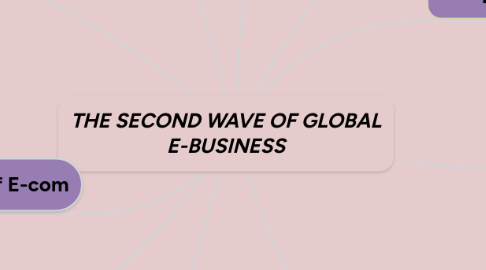
1. Development and growth of E-com
1.1. Electronic Funds Transfers (EFTs)
1.1.1. Electronic transmissions of account exchange info over private communications networks
1.2. Electronic Data Interchange (EDI)
1.2.1. Process of one business transmitting computer-readable data in standard format to another bus
1.3. Trading Partners
1.3.1. Businesses engaging in EDI with each other
1.4. Value-added Network
1.4.1. Independent firm offering EDI connection and transaction-forwarding services
2. Advantages of E-com
2.1. Can help increase profits
2.2. Can increase sells and decrease costs
2.3. Well done advertising on web can be powerful
2.4. Increases purchasing opportunities of the buyer
2.5. Can be used to identify new suppliers and business patners
2.6. Increases speed and accurancy
2.7. Can be easier to audit and monitor
2.8. Used to reach small groups of clients
3. Disadvantages of E-com
3.1. Cause some business to be unable to keep up
3.2. Some products hard to sell online
3.3. High cost to get started
3.4. Can face cultural and legal barriers
4. Economic Forces and E-com
4.1. Transaction cost
4.1.1. Info are gathered to negotiate a purchase-sale transaction
4.2. Markets and Hierarchies
4.2.1. Form of organizaion, starting products goes through the chain to the retailer
4.3. Reducing transaction Cost
4.3.1. Improve flow of info and increase coordination of actions
5. Value Chain Management
5.1. Primary activities
5.1.1. Identify customers
5.1.2. design
5.1.3. Purchase materials and suppliers
5.1.4. Manufacture product or create service
5.1.5. Market and sell
5.1.6. Deliver
5.2. Secondary activities
5.2.1. Finance and admin
5.2.2. Human resources
5.2.3. Tech.development
6. Sample definitions
6.1. Electronic Commerce-business trading with other businesses and internal processes that companies use the support their buying, selling, hiring, planning, and other activities.
6.2. Electronic Business - the information of key business processes through the use of internet technologies.
7. Categories of E-com
7.1. Business-to-Consumer (B2C)
7.1.1. Consumer shopping on the web
7.2. Business-to-Business (B2B)
7.2.1. Transactions conducted between businesses on web,called as E-producement
7.3. Business Processes
7.3.1. Group of logical,related and sequential activities in which business engage
7.4. Consumer-to-Consumer (C2C)
7.4.1. Individuals that buy and sell among themselves
7.5. Business-to-Gov (B2G)
7.5.1. Business transactions with government agencies
8. E-com waves
8.1. First Wave
8.1.1. E-com dominated by US companies
8.1.2. Most E-com websites are English
8.1.3. Easy access to start-up capital led to an overemphasis on creating large enterprises to exploit E-com opportunities
8.1.4. Internet technologies were slow and inexpensive
8.1.5. Bar codes and scanners were used to track inventories and production
8.2. Second Wave
8.2.1. Global enterprises in many countries participate in E-com
8.2.2. Websites in multiple languages
8.2.3. Rapid increase in broadband users
8.2.4. B2B E-com is increasingly integrated with radio-frequency identification
9. Identifying Business Unit Opportunities
9.1. Strengths
9.1.1. It is strong in market ?
9.2. Weaknesses
9.2.1. Does the company do poorly ?
9.3. Opportunities
9.3.1. Do new market exist for the companies products ?
9.4. Threats
9.4.1. What is competition doing well ?
